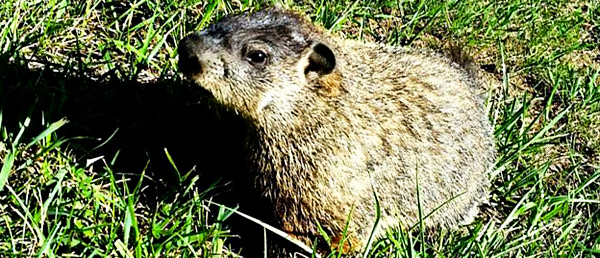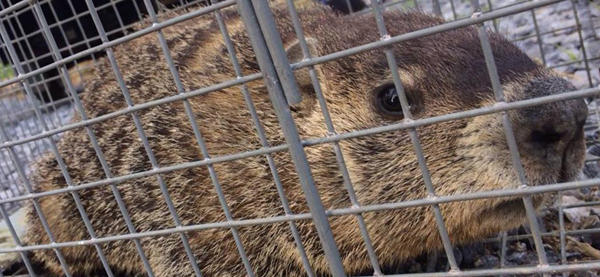- info@wildlife-removal.com
Call us for help in your town
Wildlife Removal Education
Groundhogs
Need groundhog removal in your hometown? We service over 500 USA locations! Click here to hire us in your town and check prices - updated for year 2020.
Also called woodchuck or land beaver, the groundhog is the largest species of the squirrel family. Groundhogs are naturally predated by coyotes, lynxes, snakes, foxes, hawks, owls, dogs, and wolves among others.

Appearance
Groundhogs have an average length of 20 inches and average weight of 6 kg. The body is generally covered with brown fur, which also extends to their short bushy tails. They have small eyes and two incisors that grow continuously throughout their life; these teeth are used for gnawing at foods and wood. The groundhog also has short but strong legs with claws at the ends; these claws are very essential for its digging lifestyle.
Behavior
Groundhogs mostly live in underground structures, farms and so on from where they actively search for food two times a day - early in the morning as well as early evening. They are not just great burrowers, they are also good climbers.
They hibernate from late fall to late winter or early spring and thus are inactive and unable to find food. Therefore they make sure to eat a lot of food during summer which they store up as fat reserves that can be drawn from during inactivity in the winter.
Diet
They are mostly herbivores, their main foods being grass, seeds, leaves, berries, nuts, fruits, bark and buds of tress, and other agricultural crops. Groundhogs also eat insects, snails, grubs and more when their preferred foods are scarce in order to survive.
Groundhogs eat a lot of vegetables and other agricultural crops, which makes farmers and gardeners their enemies as well.
Life cycle
The mating period for groundhogs happens during early winter immediately after they stop hibernating. The female and male groundhogs that are mated will stay together all through the 31 to 32 days gestation period. The female then gives birth to two to four blind, hairless kits and the mother takes care of the young ones alone until they are old enough to be independent at 5 to 6 weeks of life.
The young ones usually leave the mother groundhog after 8 weeks, but it takes up to 12 months for them to start breeding. Groundhogs only breed once each year. They have a lifespan of 3 to 5 years depending on predation, human activities and environmental conditions.
Habitat
Groundhogs are basically adapted to living in temperate habitats in North America. They are mainly found in Central and Eastern United States of America, Alaska and Canada with some also found in Central Mexico. Groundhogs live inside burrows which they dig with their claws, and they make their burrows around residential structures, home foundations, trees and so on.
Also called woodchuck or land beaver, the groundhog is a large rodent of the squirrel family. It is actually the largest species of the squirrel family. Groundhogs are naturally predated by coyotes, lynxes, snakes, foxes, hawks, owls, dogs, and wolves among others. However, they are mostly able to protect themselves from these predators by digging and hiding inside their burrows.

Appearance
Groundhogs have an average length of 20 inches and average weight of 6 kg. Their body is generally covered with brown fur, which also extends to their short bushy tails. They have small eyes and two incisors that grow continuously throughout their life; these teeth are used for gnawing at foods and wood. The groundhog also has short but strong legs with claws at the ends; these claws are very essential for its digging lifestyle.
Behaviour
Groundhogs mostly live in underground structures, farms and so on from where they are active two times a day - early in the morning as well as early evening. Whenever they come out of their burrows, it is basically to look for food. They are not just great burrowers, they are also good climbers.
They hibernate from late fall to late winter or early spring and thus are inactive and unable to find food. Therefore they make sure to eat a lot of food during summer which they store up as fat reserves that can be drawn from during inactivity in the winter. When groundhogs hibernate, they curl themselves up like a ball and their heart rate falls significantly from 75 to 4 beats per minute. Their body temperature is usually just as low as that of the burrow in which they are hibernating.
They are solitary animals and only meet during mating season, and they seldom come out to protect each other when in danger. Groundhogs are polygamous, so a male groundhog can mate with many females during early spring.
Groundhogs, which are often hunted by humans for sports, do not have a very cordial relationship with humans, no thanks to their destructive tendencies. Though they do not infringe on space meant for man, they rather make burrows to live in underneath human structures. And their digging efforts in making these burrows can cause structural damage and cracks to building foundations, walls, farmyards, gardens. etc. Groundhogs eat a lot of vegetables and other agricultural crops, so if they find their way into a garden, they will destroy it in little time.
Diet
They are mostly herbivores, their main foods being grass, seeds, leaves, berries, nuts, fruits, bark and buds of tress, and other agricultural crops. Groundhogs also eat insects, snails, grubs and more when their preferred foods are scarce in order to survive.
Groundhogs can eat foods up to 30% of their body weight each day and they eat even more during summer to store up a fat reserve, which they utilize during winter when they hibernate.
Life cycle
The mating period for groundhogs happens during early winter immediately after they stop hibernating. The female and male groundhogs that are mated will stay together all through the 31 to 32 days gestation period. The female then gives birth to two to four blind, hairless kits and the mother takes care of the young ones alone until they are old enough to be independent at 5 to 6 weeks of life.
The young ones usually leave the mother groundhog after 8 weeks, but it takes up to 12 months for them to start breeding. Groundhogs only breed once each year. They have a lifespan of 3 to 5 years depending on predation, human activities and environmental conditions.
Habitat
Groundhogs are basically adapted to living in temperate habitats in North America. They are mainly found in Central and Eastern United States of America, Alaska and Canada with some also found in Central Mexico. Groundhogs live inside burrows which they dig with their claws, and they make their burrows around residential structures, home foundations, trees and so on. They make use of these burrows for raising young ones, sleeping, storing foods and hibernating.
Groundhog Day
Groundhog day is popularly celebrated every 2nd of February in Pennsylvania, Canada, and Texas among other locations. It symbolizes the approach of the end of Winter.
Go back to the Groundhog Removal page.


















